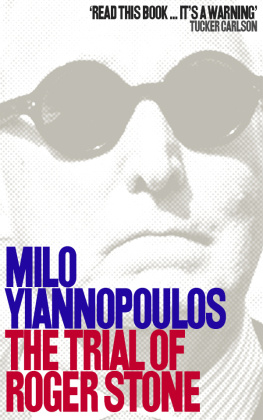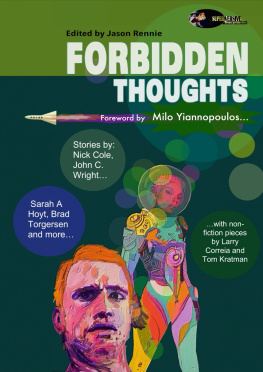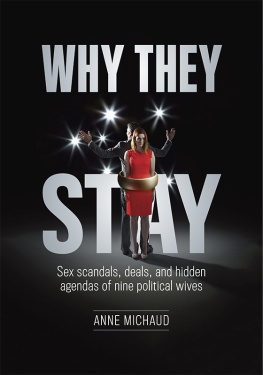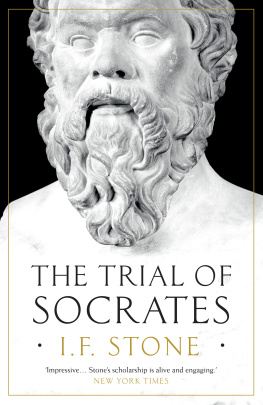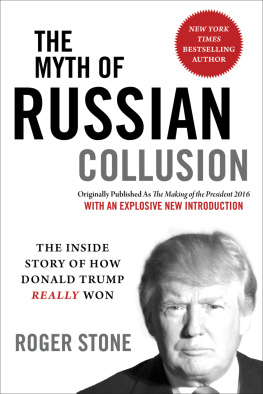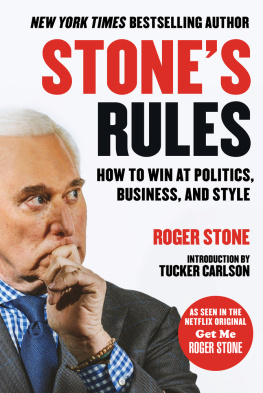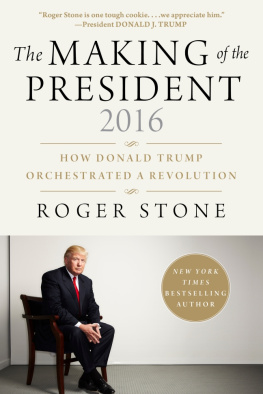The Trial of Roger Stone

Milo Yiannopoulos
THE TRIAL OF ROGER STONE
Milo Yiannopoulos
Copyright 2020 by Milo Yiannopoulos
All rights reserved. This book or parts thereof may not be reproduced in any form, stored in a retrieval system, or transmitted in any form by any meanselectronic, mechanical, photocopy, recording, or otherwisewithout prior written permission of the publisher.
Second edition, 2020
Cover Design: Milo Yiannopoulos
Interior Artwork: Exxumed
Courtroom Sketches: Leigh Brown
leighbrownart.com
Photography: Mike Allen
Published by Dangerous Books
By the Same Author
Dangerous
Diabolical: How Pope Francis Has Betrayed Clerical Abuse Victims Like MeAnd Why He Has To Go
How To Be Poor
Middle Rages: Why The Battle For Medieval Studies Matters To America
How To Be Straight
Coming soon
Feminism is Cancer: A Survival Guide
How To Be Black
To John:
Marriage to you
is never a trial.
Its rare that Im accused of something Im not guilty of.
Roger Stone
Introduction: Stones Rules
Its my understanding that Mr. Stone has brought his own sketch artist to court with him today, said Judge Amy Berman Jackson, reproachfully, before ordering the young woman in question to leave the room. If you know a little about Roger Stone already, this story will sound plausible to youperhaps even likely. Of course he did. Thats so on brand! Especially for a man whos said to have once remarked: Im photosensitive. Im sensitive when people dont take photos.
There was just one problem. It never happened. The judge was mistaken. The truth of this sketch-artist skirmish was much less eyebrow-raising than the Twitter commotion suggested: A female artist sympathetic to Stone showed up on the first day of trial, without his knowledge. The courts own security guard let her sit in the little reserved bullpen in front of the normal gallery, alongside the court-appointed artist. One of the judges rotund, beady-eyed bevy of female clerks noticed, reported it to Judge Jackson, andhey, presto!another thread of Stone mythology was woven into the public record, with no hope of future correction.
This fake story, spread endlessly by gossipy reporters covering the case, made Stone look as though he wasnt taking his criminal trial seriously. That can have serious consequences to a man facing jail time, or entreating the judge for an appeals bondespecially, as we will see, when the judge in question is one of the most ferociously partisan members of the federal judiciary. Basically, when youre dealing with an enemy who will take any tweet, any joke, any remark, any meme anything, and, if at all possible, contort and repackage and misrepresent it as a threat, or a lie, or evidence of witness tampering well, a history of sassy remarks and a natural inclination toward showmanship and performance art can be a liability.
As a former senior editor for Breitbart, a New York Times-bestselling author and an international political celebrity and free speech icon, Ive heard my share of so-called conspiracy theories. Ive heard conservatives talk endlessly about double standards and unfair treatment. Ive listened as Republicans have complained about how theyre regarded versus their Democrat peers. Most of the time, the conservatives are right. Almost all of the things they claim are true! Wait long enough and the things you hear on conservative talk radio generally prove to be pretty much spot-on. These revelations have come thick and fast in the past half-decade, because the Trump presidency has exposed collusion, cronyism and entrenched bureaucracies in the federal government at a scale that has stunned most Americans.
But never in my life have I sat in a courtroom and watched a put-up job unfold before my very eyes, and experienced a chill creeping down my spine as I slowly come to realize the terrifying power of a team of government lawyers determined to take someone down, whether they committed a crime or not, and how the full might of the American jurisprudential system kneels to accommodate them.
In November 2019, Roger Stone was found guilty of one count of obstructionthat is, of lying to Congress during an investigationfive counts of making a false statement to the government, and one count of tampering with a witness. Of all these charges, the last is the most preposterous. But none of them should ever have been brought against him.
This book is about getting justice for some of the people this abusive, overweening and institutionally Left-leaning federal government apparatus has hurt, especially since this President was elected. Its about a broken and illegitimate Special Counsel system that will haunt and handicap every President until it is overhauled. And, finally, its about what the current incumbent of the Oval Office, Donald J. Trump, can and must do to make things right and unravel a horrible injustice.
But first, let me tell you about the hero of our story. Roger Stone is sixty-seven, though he does not look it. He is one of those older men who has somehow maintained an athletic build well into his more advanced years. His hair is bleached white, or sometimes a sort of cream, depending on the salon and Stones mood. You will never catch him with roots: He is far too well-maintained for that. He understands that appearances are, if not everything, then at least most of the time enough, which is why he owns a hundred tailor-made suits in a variety of styles, most of which you would nonetheless describe as Mafioso opulence.
He sports a year-round tan, which he considers an essential part of his self-presentation, and has, I would say, two primary modes of facial expression. One is kind and faintly amusedthis is uncle Roger leaning in to his natural charm, a sort of airy nonchalance of the type the Italians have perfected. The other is a distinctive downward smile that is really more of a snarland this what people mean when they talk about the dangerous political operative Roger Stone. This snarl-smile has the effect of drawing attention to his very slightly pointed ears, and gives him the impression of a mongoose about to bite the head off a snake, which is as good a description of Stones political career as I can think of.
To the odious, monotonously-uniformed army of Washington, D.C. insiders and swamp creatures, you would say that Roger is pretentious and silly, and indeed people with no imagination or love of style describe themselves as quickly bored by his affectations. But the funny thing about Roger Stone is that his style is so much more sincere than theirs is. He shows us who he is. The unvarying sartorial drabness of D.C. is really a kind of camouflage: Underneath the sameness hide intrigue, plotting, and a surreal degree of amorality. Roger, on the other hand, is who he says he is, and he is how he dresses, and this feels real, and it is perhaps the true, atavistic reason they hate him so much: He allows himself authenticity.
One of the many parts Stone plays on our T.V. screens is that of court jester or Holy Fool: the colorful truth-teller in the middle of it all, who dances playfully for the amusement of the crowd, but in whose jokes the plain truth resides while all around him are dodging the question. In literature, the jester is often the only one telling the truth at Courtand the only one with a direct connection to the audience. Stone eschews the false solemnity and social mores of the D.C. elites, recognizing them as a mask worn by the truly malevolent. As we will discover, Roger the Joker is the only one who tells the truth from start to finishthe Fool keeps his oath, as all around him are breaking their word.

